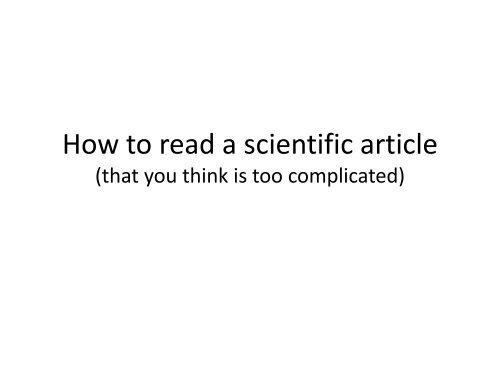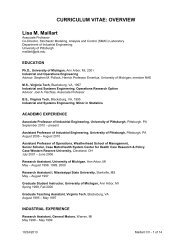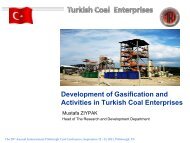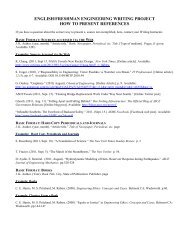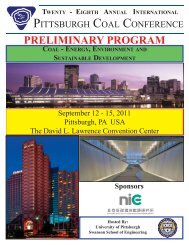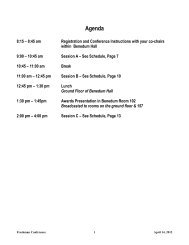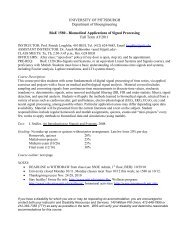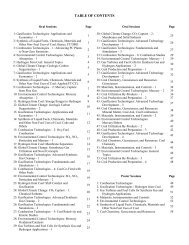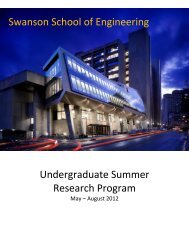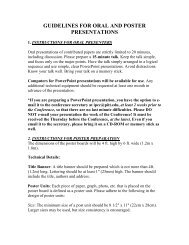How to read a scientific article (that you think is too complicated)
How to read a scientific article (that you think is too complicated)
How to read a scientific article (that you think is too complicated)
You also want an ePaper? Increase the reach of your titles
YUMPU automatically turns print PDFs into web optimized ePapers that Google loves.
<strong>How</strong> <strong>to</strong> <strong>read</strong> a <strong>scientific</strong> <strong>article</strong>(<strong>that</strong> <strong>you</strong> <strong>think</strong> <strong>is</strong> <strong>to</strong>o <strong>complicated</strong>)
The paper…WHA?!Source: Chem<strong>is</strong>try of Materials. 2010. Volume 22. Pages 4153-4157.
Fear Not! We can figure th<strong>is</strong> out(more or less)Scientific papers can be tricky, but <strong>you</strong> don’tneed <strong>to</strong> <strong>read</strong> the whole thing <strong>to</strong> get the g<strong>is</strong>t of theresearch therein.For starters, <strong>you</strong>’ll need <strong>to</strong> understand:• <strong>How</strong> the paper <strong>is</strong> structured• What <strong>you</strong> need <strong>to</strong> <strong>read</strong> in the beginning• What <strong>to</strong> do if <strong>you</strong>’re stuck• What <strong>to</strong> do if <strong>you</strong>’re still interested at the end
<strong>How</strong> <strong>is</strong> the paper structured?Most <strong>scientific</strong> papers follow the general structure outlined below. Some fieldsof research follow slightly different structures – keep an eye on the papers in <strong>you</strong>r field and<strong>you</strong>’ll start <strong>to</strong> see the patterns.• Title/Authors – Th<strong>is</strong> <strong>is</strong> the basic information for the <strong>article</strong>, prettyself-explana<strong>to</strong>ry• Abstract – A general run-down of all of the contents of the paper• Introduction – The “why” of the research project – putting th<strong>is</strong>research in the context of the greater research community• Methods – <strong>How</strong> did the researchers do what they did? Why did theydo it <strong>that</strong> way?• Results – Th<strong>is</strong> <strong>is</strong> what happened when they did the research andwhat they <strong>think</strong> it means.• D<strong>is</strong>cussion – Th<strong>is</strong> <strong>is</strong> how the results fit in<strong>to</strong> the corpus of otherresearch of th<strong>is</strong> sort. Th<strong>is</strong> <strong>is</strong> also where the authors talk about whywhat happened (Results) <strong>is</strong> important (or not).• Conclusions – Usually provides an overview of the research. Alsoprovides the <strong>read</strong>er with the answer <strong>to</strong> the “who cares?” question –why <strong>is</strong> the research important?
Do I need <strong>to</strong> <strong>read</strong> all of <strong>that</strong>?• The short answer <strong>is</strong> NO!• Follow these steps <strong>to</strong> get a simple overview of the paper:1. Read the abstract2. Read the beginning and end of the introduction3. Look at the figures and tables including the captions4. Read the Conclusions section (or last couple ofparagraphs of the paper)
1. Read the Abstract123The abstract will basically tell <strong>you</strong> everything important about the paper. In th<strong>is</strong>case, the paper indicates <strong>that</strong> the researchers:1) modified graphene oxide paper with something called alkylamines2) found <strong>that</strong> variability in the products depended on something called thealkyl chain (including a reduction in paper strength)3) found <strong>that</strong> “effective graphene oxide moduli” were unchanged…but wait! I don’t know what those terms mean!
1. Read the Abstract123No problem – look ‘em up!Use basic sources such as dictionaries and Wikipedia <strong>to</strong> get a sense for what thecomplex terms in the paper mean.Don’t forget <strong>to</strong> search for the terms in the paper itself <strong>to</strong> see if <strong>you</strong> can usecontext <strong>to</strong> figure things out…
1. Read the Abstract123No problem – look ‘em up!Graphene oxide paper – “…a composite material fabricated from graphene oxide… The material has exceptionalstiffness and strength, due <strong>to</strong> the intrinsic strength of the two-dimensional graphene backbone and <strong>to</strong> its interwovenlayer structure which d<strong>is</strong>tributes loads… graphene oxide paper <strong>is</strong> an electrical insula<strong>to</strong>r; however, it may be possible <strong>to</strong>tune th<strong>is</strong> property, making the paper a conduc<strong>to</strong>r or semiconduc<strong>to</strong>r, without sacrificing its mechanical properties.” (fromWikipedia)Gallery spacing – Refers <strong>to</strong> the spacing between layers of graphene. Figured th<strong>is</strong> out by doing a quick search for“spacing” in the paper and deducing the meaning by context.Alkylamine – th<strong>is</strong> <strong>is</strong> an amine (ammonia derivative) with an alkyl group attached. Figured th<strong>is</strong> out by looking in thedictionary! A quick search for “alkylamine” in the paper shows <strong>that</strong> the authors have previous information suggesting<strong>that</strong> alylamines will be useful for th<strong>is</strong> type of work (see the first paragraph of Results and D<strong>is</strong>cussion)Moduli – refers <strong>to</strong> the “stiffness” of the material. Figured th<strong>is</strong> out by doing a quick search for “moduli” in the paper andfound <strong>that</strong> the authors are referring <strong>to</strong> Young’s Modulus, which I then looked up in Wikipedia.
1. Read the AbstractSo what does th<strong>is</strong> all mean? Lets re-<strong>read</strong> the Abstract and see if we cantranslate:Graphene oxide paper was modified using alkylamines. The length of the alkylchain (in the alkylamine) <strong>is</strong> correlated with changes in the structure of theresultant graphene paper – specifically, longer alkyl chains resulted in mored<strong>is</strong>tance between graphene sheets and decrease in tensile strength. <strong>How</strong>ever,the flexibility of the graphene paper was not affected.WOW! Now we know the basics of the paper. Lets dig a little deeper…123
2. Read the beginning and end of theintroductionBeginning:End:The beginning and the end of theIntroduction are most likely <strong>to</strong> giveus background in<strong>to</strong> why theresearch was conducted(beginning) and either anintroduction of the goals of theresearch or a complete overview ofthe research including results(end).At th<strong>is</strong> point, there <strong>is</strong> a lot of junkin the middle of the introduction<strong>that</strong> <strong>is</strong> probably confusing and notrelevant <strong>to</strong> getting a g<strong>is</strong>t of thepaper…so ignore it for now.
2. Read the beginning and end of theintroductionBeginning:Nanotech fabrication show prom<strong>is</strong>e notseen in ‘<strong>to</strong>p-down’ assembly methodsNano-paper <strong>is</strong> especially cool (e.g.graphene oxide) for mechanical,electrical, and optical stuffThe beginning of the <strong>complicated</strong> and(for now) not relevant stuff. E.g. “Blah,blah, blah, what we’ve done before andwhy we’re qualified, blah, blah.”End:<strong>How</strong> handy! A conc<strong>is</strong>e overview of theresearch project presented in th<strong>is</strong> paper,using slightly different language from theabstract!
2. Read the beginning and end of theintroductionNow we have a really good idea ofwhat the paper <strong>is</strong> about based onthe Abstract and the last paragraphof the Introduction.Beginning:AND we have a good idea of whyth<strong>is</strong> research <strong>is</strong> important based onthe first part of the Introduction.End:
3. Look over the figures and tables,including the captionsBased on what we know so far, wecan now go through, VERY QUICKLY,and see what the figures and tablesshow.If something <strong>is</strong> <strong>to</strong>o <strong>complicated</strong>,just move on <strong>to</strong> the next item.You’ll see <strong>that</strong> <strong>you</strong> al<strong>read</strong>y know alot about the results from lookingat the Abstract and Introduction!
3. Look over the figures and tables,including the captionsOooh! Pictures ofgraphene oxide ofdifferentthicknesses!Neat! Th<strong>is</strong> figureshows how the alkylchain length affectsgallery spacing(remember <strong>that</strong>from the Abstract?)
3. Look over the figures and tables,including the captionsAh, yes, a reduction intensile strength (y-ax<strong>is</strong>) withincrease in alkyl chainlength (x-ax<strong>is</strong>) – asmentioned in the AbstractModulus (x-ax<strong>is</strong>; flexibility) andalkyl chain length. No change inmodulus with increase in alkylchain length except at C12 (long)alkyl chain lengths…
3. Look over the figures and tables,including the captionsOooh! Morepictures! Not surewhat they meanthough…
4. Read the ConclusionsWe’ve got th<strong>is</strong> thing mostly figured out. Lets just look over theConclusions section <strong>to</strong> see if there are any more interestingtidbits.Here, they reiterate what they did. Wepretty much understand th<strong>is</strong> stuff, but ifwe were still confused, we could lookhere for clarification.Th<strong>is</strong> <strong>is</strong> helpful. The authors give anoverview of why th<strong>is</strong> research <strong>is</strong>important: graphene oxide paper can beused <strong>to</strong> s<strong>to</strong>re stuff between layers whileretaining most of its physical properties!
Now what?Well, now <strong>you</strong>’re done. You’ve got the g<strong>is</strong>t of the paper,understand the results, and have a sense for why its important.If there was anything <strong>you</strong> <strong>read</strong> <strong>that</strong> really piqued <strong>you</strong>r interest,<strong>you</strong> can go back and thoroughly <strong>read</strong> the Introduction, Methods,Results, or D<strong>is</strong>cussion sections. Otherw<strong>is</strong>e, take some notes andmove on <strong>to</strong> the next paper.Congratulations Scient<strong>is</strong>t!
FAQQ: Will th<strong>is</strong> method work for every paper?A: NO! There will definitely be cases for which no matter how closely <strong>you</strong> followthese guidelines, the paper will still be <strong>to</strong>o <strong>complicated</strong>. If <strong>you</strong> run in<strong>to</strong> one of thosepapers, it <strong>is</strong> probably <strong>to</strong>o specialized for <strong>you</strong>r work at th<strong>is</strong> point, so <strong>you</strong> can eithermove on <strong>to</strong> a different paper or, if <strong>you</strong>’re ambitious, find an expert <strong>to</strong> help <strong>you</strong>(professor, TA, or even a librarian!).Q: Do all papers have the same structure?A: No, some fields of research have pretty different paper structures, but in mostcases, some or all of the components are there, they just aren’t labeled as clearly.Q:A:


